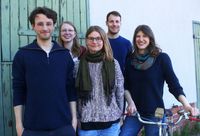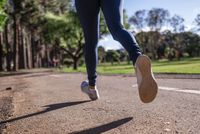Healthy mobility transition:
Facilitating active mobility in cities
In the AMBER project, we are using citizen science studies and an interdisciplinary mix of methods to investigate which measures will make it easier to switch from cars to active mobility. The team is also investigating how the health-promoting effects of cycling, walking etc. can be sustainably improved.
Why active mobility?
We want to understand how healthy, active and climate-friendly mobility in cities can become more attractive – and how weather changes due to climate change need to be taken into account. Here we present our project and explain, among other things, why bus and train travel is also part of active mobility.
Practical research
Researchers from the fields of health and environmental psychology, public health, meteorology, and sustainability management work closely with practice partners such as the ADFC and Changing Cities. An international scientific advisory board regularly exchanges ideas with the researchers.
Impulses for a healthy mobility transition
How healthy is active mobility in the city? When are cycling and walking perceived as pleasant? How can new mobility routines be established in daily life – and what can companies and civil society contribute to this? We provide some initial insights into these questions here.
News
Kick-off meeting: Citizen science study starts
Over 250 people have registered for the study in Berlin. They will soon be making their first observations about their daily mobility. But first, all questions about the process, the study app and the research groups will be answered at the kick-off meetings.
On April 2, the first of a total of 18 kick-off meetings took place throughout Berlin. All participants choose one of these dates. This is the starting signal for their time as Citizen Scientists in “Mobil auf Deine Weise”.
It is still possible to register for one of the kick-off meetings in the first and second week of April.
Mobility, health and discrimination: An intersectional workshop at FU Berlin
What do migration histories, disabilities, gender or age have to do with our mobility – and with our health? Which forms of discrimination are still deeply rooted in society and how can we be sensitive to them in our citizen science study? How can we instead appreciate and highlight diversity? The AMBER team explored these questions in an intensive workshop on March 6, 2025, led by Ed Greve from the Migration Council Berlin and Stefanie-Layha Aukongo, artist and activist.
Healthy mobility for all: Citizen Science Study “Be Mobile in Your Own Way” in Berlin
On foot, by bike, with a walking frame or pram, in a wheelchair, by car or public transport: a city's mobility is as diverse as its inhabitants. How can the city of Berlin better meet these different needs? A citizen science study will be launched in April 2025. The Freie Universität Berlin and the Institute for Ecological Economy Research (IÖW) are inviting people to take part in the study under the motto “Be Mobile in Your Own Way”. The aim is to find out what barriers exist for people who want to move around the city in a healthy way. Registration for the study is open until the 1st of April 2025.


